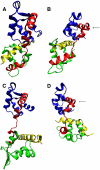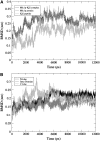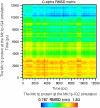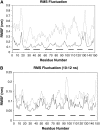A molecular dynamics study and free energy analysis of complexes between the Mlc1p protein and two IQ motif peptides
- PMID: 16844751
- PMCID: PMC1562369
- DOI: 10.1529/biophysj.106.085399
A molecular dynamics study and free energy analysis of complexes between the Mlc1p protein and two IQ motif peptides
Abstract
The Mlc1p protein from the budding yeast Saccharomyces cerevisiae is a Calmodulin-like protein, which interacts with IQ-motif peptides located at the yeast's myosin neck. In this study, we report a molecular dynamics study of the Mlc1p-IQ2 protein-peptide complex, starting with its crystal structure, and investigate its dynamics in an aqueous solution. The results are compared with those obtained by a previous study, where we followed the solution structure of the Mlc1p-IQ4 protein-peptide complex by molecular dynamics simulations. After the simulations, we performed an interaction free-energy analysis using the molecular mechanics Poisson-Boltzmann surface area approach. Based on the dynamics of the Mlc1p-IQ protein-peptide complexes, the structure of the light-chain-binding domain of myosin V from the yeast S. cerevisiae is discussed.
Figures






Similar articles
-
Myosin V movement: lessons from molecular dynamics studies of IQ peptides in the lever arm.Biochemistry. 2007 Dec 18;46(50):14524-36. doi: 10.1021/bi701342y. Epub 2007 Nov 20. Biochemistry. 2007. PMID: 18020453
-
Two distinct myosin light chain structures are induced by specific variations within the bound IQ motifs-functional implications.EMBO J. 2003 Feb 3;22(3):362-71. doi: 10.1093/emboj/cdg058. EMBO J. 2003. PMID: 12554638 Free PMC article.
-
Structural basis for the interaction of the myosin light chain Mlc1p with the myosin V Myo2p IQ motifs.J Biol Chem. 2007 Jan 5;282(1):667-79. doi: 10.1074/jbc.M607016200. Epub 2006 Oct 29. J Biol Chem. 2007. PMID: 17074768
-
Do longer oars row farther?Mol Cell. 2002 Nov;10(5):966-7. doi: 10.1016/s1097-2765(02)00748-7. Mol Cell. 2002. PMID: 12453404 Review. No abstract available.
-
Myosins in yeast.Curr Opin Cell Biol. 1997 Feb;9(1):44-8. doi: 10.1016/s0955-0674(97)80150-0. Curr Opin Cell Biol. 1997. PMID: 9013666 Review.
Cited by
-
A Fragmenting Protocol with Explicit Hydration for Calculation of Binding Enthalpies of Target-Ligand Complexes at a Quantum Mechanical Level.Int J Mol Sci. 2019 Sep 6;20(18):4384. doi: 10.3390/ijms20184384. Int J Mol Sci. 2019. PMID: 31489952 Free PMC article.
-
Interaction of miR-155 with Human Serum Albumin: An Atomic Force Spectroscopy, Fluorescence, FRET, and Computational Modelling Evidence.Int J Mol Sci. 2022 Sep 14;23(18):10728. doi: 10.3390/ijms231810728. Int J Mol Sci. 2022. PMID: 36142640 Free PMC article.
-
Interaction between miR4749 and Human Serum Albumin as Revealed by Fluorescence, FRET, Atomic Force Spectroscopy and Computational Modelling.Int J Mol Sci. 2022 Jan 24;23(3):1291. doi: 10.3390/ijms23031291. Int J Mol Sci. 2022. PMID: 35163220 Free PMC article.
-
Investigation of a Direct Interaction between miR4749 and the Tumor Suppressor p53 by Fluorescence, FRET and Molecular Modeling.Biomolecules. 2020 Feb 22;10(2):346. doi: 10.3390/biom10020346. Biomolecules. 2020. PMID: 32098369 Free PMC article.
-
Vitamin D3 and its hydroxyderivatives as promising drugs against COVID-19: a computational study.J Biomol Struct Dyn. 2022;40(22):11594-11610. doi: 10.1080/07391102.2021.1964601. Epub 2021 Aug 20. J Biomol Struct Dyn. 2022. PMID: 34415218 Free PMC article.
References
-
- Yamniuk, A. P., and H. J. Vogel. 2004. Calmodulin's flexibility allows for promiscuity in its interactions with target proteins and peptides. Mol. Biotechnol. 27:33–57. - PubMed
-
- Chin, D., and A. R. Means. 2000. Calmodulin: a prototypical calcium sensor. Trends Cell Biol. 10:322–328. - PubMed
-
- Vogel, H. J., R. D. Brokx, and H. Ouyang. 2002. Calcium-binding proteins. Methods Mol. Biol. 172:3–20. - PubMed
-
- Wilson, M. A., and A. T. Brunger. 2000. The 1.0 Å crystal structure of Ca2+-bound calmodulin: an analysis of disorder and implications for functionally relevant plasticity. J. Mol. Biol. 301:1237–1256. - PubMed
-
- Yun, C. H., J. Bai, D. Y. Sun, D. F. Cui, W. R. Chang, and D. C. Liang. 2004. Structure of potato calmodulin PCM6: the first report of the three-dimensional structure of a plant calmodulin. Acta Crystallogr. D Biol. Crystallogr. 60:1214–1219. - PubMed
Publication types
MeSH terms
Substances
LinkOut - more resources
Full Text Sources
Molecular Biology Databases

